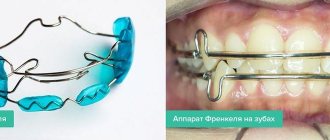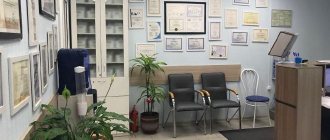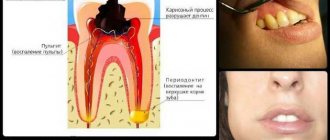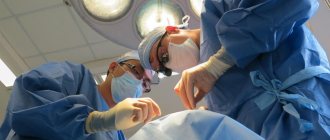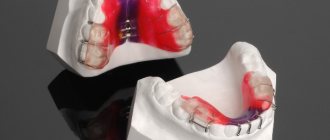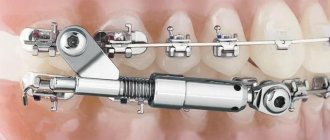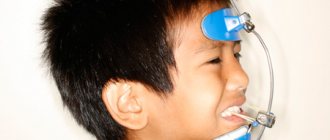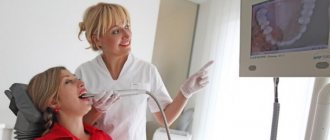In most cases, bite correction is required from early childhood. During this period, bone tissue is not yet fully formed and therefore much easier to correct. To treat distal occlusion in children, the Andresen-Goipl activator is often used, a design that has been used in orthodontics since the first half of the last century. Since then, the device has undergone some changes, but the principle of operation has remained unchanged. In our article you will find all the necessary information about this orthodontic device.
Design features
This is a removable, combined device consisting of two bases. Its upper and lower parts are connected to each other, forming a single block. The position that is given to the Andresen-Goipl apparatus during connection along the occlusal surfaces is determined by the doctor depending on the existing pathology.
The upper part is a plate with two wings, adjacent to the sky. It is equipped with a wire arch with loops in the area of the canines and first premolars. The arch is located between the canines of the upper jaw.
The upper part lags behind the distal edges, touching the mesial ones. The bottom one is made exactly the opposite. Before using the plate, the plastic in the area adjacent to the teeth being moved is scraped out. In the photo you can see what this device is.
Operating principle
As mentioned, the main purpose of the Andresen-Goipl activator is related to the treatment of distal occlusion. Its principle of operation is to securely fix the lower jaw in a moved, extended position. Through the use of the device, the growth of the lower jaw is activated and the development of the upper jaw is suspended.
The functions of the facial and masticatory muscles are normalized, the position of the teeth changes in the desired direction thanks to inclined planes, Coffin springs, a screw and a vestibular arch.
The device may have a slightly different design structure depending on the complexity of the pathology. The doctor, at his own discretion, determines the presence of certain elements in the design.
Similar orthodontic appliances
The Andresen-Goipl activator refers to closed two-jaw orthodontic devices. However, there are also open monoblocks that do not cover the palate and the front parts of the teeth. Open ones include:
- Janson Bionator. Often used for prognathic distal occlusion. Restrains the growth of the upper row, due to which the bite is corrected.
- The Klammt activator is prescribed to correct the uncharacteristic arrangement of the anterior teeth, as well as for sagittal anomalies. The device has a lighter design compared to other devices. Due to the fact that there is no plastic on the roof of the mouth, the device does not impede speech and can therefore be used throughout the day.
- The Balters bionator is used to correct narrowing of the dentition, protrusion of the anterior teeth and deep bite, open bite and malocclusion of the lower jaw.
Considering that modern dentistry offers a wide range of options for solving the problem of malocclusion in children, parents will be able to give their child a beautiful smile.
What is a bionator and for what purpose is it used in orthodontics
The bionator is a multifunctional corrective system that allows you not only to correct rows and straighten the bite, but also to correct the position of the lower jaw pushed forward or solve the problem of abnormally sized teeth. With its help, you can change the inclination of the crowns, stimulate the muscles of the face and ligaments, and correct the width of the dentition. Experts in the field of orthodontics highlight several important advantages of using bionators, and here are the main ones:
- the design provides for strong fixing and supporting elements,
- the device provides a force sufficient for the systematic and effective movement of curved units,
- the action of the system can be aimed at expanding the jaw arch in order to free up space for the unhindered movement of problem teeth.
Bionator is a multifunctional corrective system.
The device combines the functions of several corrective systems at once. It can be used as a plate, the action of which is aimed at expanding the upper and mobile jaw, and also act as a trainer or retaining device used as part of the treatment of the temporomandibular joint.
Design features
The standard bionator model is a monoblock device with upper and lower plates interconnected. The block includes elements such as a plastic base, wire parts, expansion screw, guide slots and tilt planes.
Such devices come in single- and double-jaw types (monoblock). There are also removable, non-removable and combined models. According to another classification, bionators are therapeutic and prophylactic. The choice of a specific modification is at the discretion of the doctor and directly depends on the individual characteristics of the clinical picture.
Description of the Klammt device
This is a removable bimaxillary device , fixed on the teeth from the incisors to the second molar, leaving the frontal units and palatal vault free, which significantly expands the surface for the tongue and improves the functionality of the dental system.
The device is designed to correct the incorrect position of the anterior elements in several types of abnormal bite.
The device received its name based on the principle of operation, i.e. it is activated during movements of the tongue and jaw , for example, during communication. Bite correction is carried out by moving teeth in a small gap between the hardware arch and the dentition.
The Klammt device is an improved model of the classic Andresen-Goipl device. But unlike its predecessor, it has smaller parameters and a lightweight elastic design, which affects wearing comfort.
The device in its design has the following parts:
- two plastic shields adjacent to the alveolar areas of both jaws from molars to canines;
- overlay plates on the side units, covering 2/3 of their surface;
- clasp for the sky in the form of a spring;
- one pair of vestibular arches for the frontal elements of both jaws, which end in horizontal U-shaped bends that prevent biting of the mucous membrane.
This is interesting: Correcting the bite in adults - how to straighten teeth without braces
Important! According to indications, loops for tongue retraction, spring pushers, labial pads, and half-arches can be added to the device.
Indications
The use of the system is indicated in the following clinical cases, which are various manifestations of defects in the formation of the jaw apparatus:
- distal bite – corrected with the activator of the standard version. In case of a pronounced anomaly, the device can be supplemented with finger-shaped springs, bringing the position of the units back to normal;
- distal blocking bite – the device is made individually based on a dental impression.
The system is equipped with a lip bumper, which slightly reduces muscle tone in the mouth and lips. If the incisors are atypically deployed, the arch intended for the upper row has a slightly different shape and consists of two rounded fragments; - mesial against the background of reverse incisal overlap - the arch in this case is in maximum contact with the lower jaw row, but at the same time practically does not exert any external pressure on the teeth;
- open bite – for its treatment the device is equipped with a tongue shield. Wire arches are localized on the back side of the organs and do not allow the tongue to contact the incisal units;
- protrusion - the structure is installed on the outer side of the jaw at a distance of 0.2 cm from incorrectly positioned teeth so that the arch touches them as tightly as possible;
- cross pathology - involves the use of a standard device, but with a smoother surface, which must be located further away from the side elements of the row.
Contraindications
Absolute contraindications in which the use of the device is not possible:
- allergic manifestations - as the body’s reaction to individual intolerance to the materials included in the device;
- physiological rejection of foreign objects in the oral cavity, bordering on the gag reflex.
In addition, the following relative contraindications may become a temporary limitation to carrying out correction using this method, by eliminating which the ban on treatment with the Klammt device will be lifted:
- exacerbation of serious chronic diseases;
- viral infections;
- inflammatory processes in the oral cavity;
- a number of dental diagnoses that compromise the structural integrity of teeth.
Duration of treatment
The duration of wearing an orthodontic appliance will be different for each patient. The severity and severity of the pathology, which is supposed to be solved with the help of a specific device, plays a very direct role here. The individual characteristics of the patient also play a role, so at the initial stage even a certified doctor can only give an approximate treatment time. During the wearing process, when the first results become noticeable, it will be possible to make assumptions about the time of removal of the device.
The duration of correction is individual for each child. The full course of treatment can start from several months and end in 2-3 years. On average, the most common period is approximately 1.5 years. During the treatment process, the plates and some of their elements may be replaced depending on the results obtained and the necessary adjustments.
The device is usually worn only at night, since it is impossible to talk with it and breathe through the mouth. Therefore, the duration of treatment often turns out to be longer than originally planned. Before treatment, it is imperative to show the child to a therapist and otolaryngologist. If you have problems with nasal breathing, wearing this device is strictly contraindicated .
Rules and terms of wearing
The device is activated by the orthodontist once every 5-7 days. The pressure of the bite plane is adjusted once every 14-20 days by applying a layer of acrylic mass to its surface.
The structure may only be removed for eating and hygienic care. After each cleaning of the teeth and oral cavity, it is recommended to clean the device itself.
The duration of correction depends on the severity of the anomaly and the complexity of the clinical case. Minor changes in the dental system take an average of 6-18 months to correct.
After completing the phase of active influence on problem areas, a period of retention begins (consolidation of results), which lasts 3-6 months.
Manufacturing of the device
The key to successful treatment is the correct manufacture of the device, taking into account all the characteristics and problems of the patient. Basic manipulations are performed in the following sequence.
- Plaster models of both jaws are made.
- Templates are created from wax with occlusal ridges.
- Occlusal relationships are determined in the oral cavity.
- Jaw models are installed in the articulator.
- Fastening elements are created. A vestibular arch is made and, if necessary, other additional parts are selected.
- A wax reproduction of the orthodontic structure is created.
After all these manipulations, plates are made that fully meet the individual characteristics of the patient. This allows you to eliminate all malocclusions in the shortest possible time and, even at the stage of teeth formation and growth, provide the child with a beautiful and even smile in the future. More detailed and accurate information is provided by the doctor based on the examination and examination.
In the photo you have already seen what Andresen-Goipl’s orthodontic invention looks like. If your child is to be treated with a similar device, then you will probably be interested in watching the final video, which will demonstrate this device from all sides.
Explanation of diagnosis
Protrusion is a malocclusion in which the teeth are pushed forward at an angle to the jaw. When teeth are retruded, they tilt toward the inside of the mouth.
Possible causes of existing anomalies: bad habits (for example, thumb sucking) and the eruption of permanent “second row” teeth before the loss of milk teeth.
It is advisable that the child be seen by a dentist from an earlier age. Orthodontic treatment can begin at 6 years of age.
You will find more recommendations in the articles:
- A child’s beautiful smile is the care of loving parents
- Growth of baby teeth and first molars
- Why, When and How should a malocclusion be corrected?
